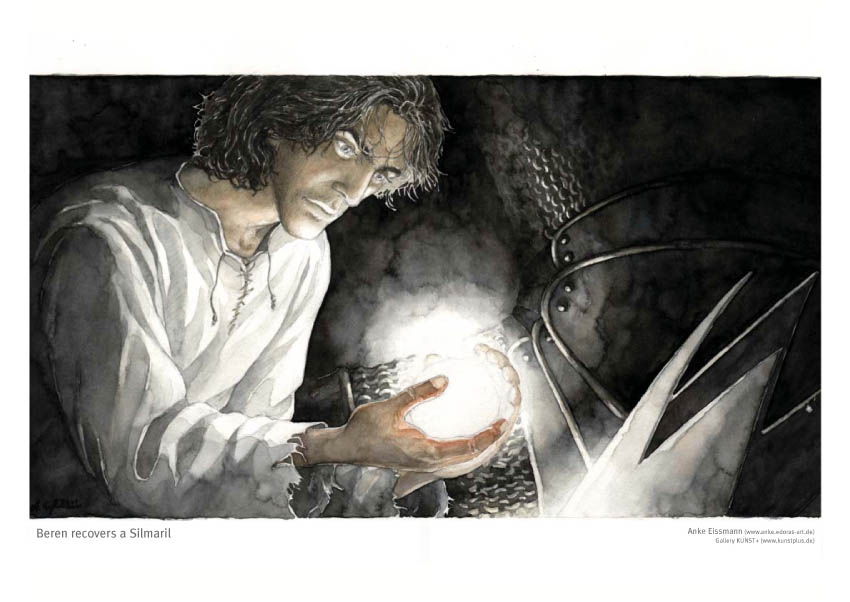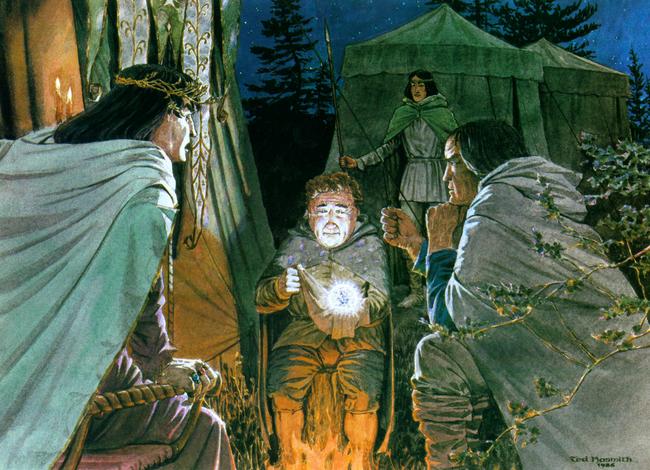Tolkien spent a great amount of time delving into the history of every person, place, and object in his legendarium, working and reworking his ideas so that nearly everything in Middle-earth was linked. Some changes made it to publication, while others did not. Such may have been the case regarding the origins of the Arkenstone, the Heart of the Mountain. While no concrete link has been made in any of Tolkien’s published works, many fans and scholars alike feel that the similarities between the Arkenstone and the Silmarils of Valinor are uncanny.
The Silmarils
The Silmarils played a pivotal role in the history of the Elves. They were the greatest of all the works of the Elves, having been crafted by the Noldorin Elf Fëanor, whose skill was so great that not even the Valar could replicate his work. They were hallowed by Varda so that no mortal, unclean, or evil hands could touch them, and it was prophesied by Mandos that “the fates of Arda, earth, sea, and air, lay locked within them” (The Silmarillion, 70).
As three great jewels they were in form. But not until the End […] shall it be known of what substance they were made. Like the crystal of diamonds it appeared, and yet was more strong than adamant, so that no violence could mar it or break it within the Kingdom of Arda. (69)
Having been blended with the light of the Two Trees, Telperion and Laurelin, the Silmarils were alive and not only reflected light, but gave off their own:
Even in the darkness of the deepest treasury the Silmarils of their own radiance shone like the stars of Varda; and yet, as were they indeed living things, they rejoiced in light and received it and gave it back in hues more marvellous than before. (69)
Just as they inspired awe, so, too, did the Silmarils inspire lust. Fëanor, who at first wore the jewels openly, soon “began to love the Silmarils with a greedy love” (71), and growing suspicious of his own kin, allowed only his father and seven sons to behold the jewels. Furthermore, when Melkor destroyed the Two Trees of Valinor, the Valar asked that Fëanor give up the jewels to restore them. But the Noldo refused, having grown fiercely possessive of the jewels and perceiving that the Valar desired to have the Silmarils for their own purpose. Later, when Melkor slew his father, Finwë, and fled to Middle-earth with the jewels, Fëanor pursued him, swearing with his sons the Oath of Fëanor, through which they were bound to fight anyone who tried to take or withhold the Silmarils from them, and through which war was waged among the Elves.
Ultimately, the Silmarils were recovered: one was retrieved from Melkor’s crown by Beren and Lúthien, and later taken by Eärendil to the Valar as a token of repentance, it was set as a star in the sky; the other two were recovered by Fëanor’s sons, Maedhros and Maglor, though the jewels burned the hands of both as a result of the evil deeds they had committed in fulfilment of their Oath. In agony, Maedhros threw himself (along with the Silmaril) into a fiery pit, and Maglos cast his gem into the sea.
And thus it came to pass that the Silmarils found their long homes: one in the airs of heaven, and one in the fires of the heart of the world, and one in the deep waters. (305)
The Arkenstone
The Arkenstone was a gem somewhat similar in description and effect, inspiring fierce possessiveness in those who beheld it. Found under the mountain by Thráin I the Old, it was a jewel of great importance to the Dwarves of Erebor, and had become the heirloom of the Kings of Durin’s Folk. Having been lost after the dragon Smaug sacked the Lonely Mountain, its recovery was what initiated the Quest of Erebor.
Thorin Oakenshield described the Arkenstone as being “like a globe with a thousand faces; it shone like silver in the firelight, like water in the sun, like snow under the stars, like rain upon the Moon!” (The Hobbit, 212). While it shone “of its own inner light”, it also “took all light that fell upon it and changed it into ten thousand sparks of white radiance shot with glints of the rainbow” (217), similar to – but perhaps less potent than – the light of the Silmarils.
While the Arkenstone was not a malicious item in and of itself, it, too, evoked greed and lust, particularly among Thorin. In earlier versions of Tolkien’s legendarium, the Arkenstone was simply a gem which Bilbo took from the dragon’s horde; it later evolved into “a marvelous gem”, and finally the “Jem of Girion”, which the King of Dale had given to the Dwarves as payment for arming his sons (The History of the Hobbit, Return to Bag End, 603). But as Bilbo’s own role in the story evolved – he went from dragon-slayer to burglar – so, too, did the gem and its history. The introduction of Bard the Bowman, the heir of Girion, led to the invention of the Necklace of Girion as the item given to the Dwarves; the Gem of Girion then became the Arkenstone, the one item in the dragon’s horde that Thorin could not bear to see in the hands of another:
“For the Arkenstone of my father,” he said, “is worth more than a river of gold in itself, and to me it is beyond price. That stone of all the treasure I name unto myself, and I will be avenged on anyone who finds it and withholds it.”(The Hobbit, 268)
Indeed, upon discovering that the hobbit had kept the Arkenstone from him, he “shook poor Bilbo like a rabbit”, “lifted Bilbo in his arms”, and “[dropped] him on top of the wall”, sending the hobbit away with curses and no share of the treasure (251). While his rage was nowhere near the level of Fëanor’s, he was fiercely possessive of what he believed was rightfully his.
It is unknown whether the Arkenstone shared the Silmarils’ property of burning the hand of any evil-doers, as it did not come into contact with any such character in The Hobbit. We do know that Bilbo, Thorin, and Bard each handled the stone in some fashion, but as none of them were truly evil in either thought or action, the stone would not have scorched them. Neither were they burned for being mortals; with the exception of Beren, the Silmarils were unfit for mortal and evil hands alike.
Eorcan and Jarknasteinn
Tolkien wrote and reworked his legendarium numerous times, so it is possible that he did, in fact, intend for the Arkenstone to be one of the Silmarils. Interestingly, the word from which both of these stones derived their names offers some insight into Tolkien’s thoughts surrounding their origins. In an Old English poem written by his fictional Anglo-Saxon character Ælfwine, Tolkien used the word Eorclanstana, derived from the Old English eorcan (‘precious stone’), to refer to the Silmarillion, or the history of the ‘holy stones’ (Silmarils). He ascribed an equivalent name to the Arkenstone; feeling it was more appropriate for the Dwarves to use a name derived from Old Norse, he Anglicised jarknasteinn (‘holy’).
Which Silmaril Could it Have Been?
There is nothing to suggest that the Arkenstone could have been a fourth Silmaril, as it is made very clear throughout The Silmarillion that there were only three such jewels, none of which could ever be replicated.
With one jewel set high in the sky, and another lost forever at sea –at least until Mandos’ prophecy comes to pass and the world is made anew – if the Arkenstone was a Silmaril, it would likely be the jewel Maedhros cast into the gaping chasm. (It is curious that this stone is described as resting in ‘the heart of the world’, while the Arkenstone is also called ‘the Heart of the Mountain’.)
In this case, the idea that the Dwarves were responsible for cutting the stone into a multi-faceted jewel would have been inaccurate. It may be that they found the jewel already in its marvellous form and (falsely) believed that it was the work of their own; nowhere is it recorded who of the Dwarves may have been responsible.
Given the continual changes made to the legendarium, it is difficult to know definitively whether or not the Arkenstone was one of the Silmarils; but Tolkien’s own manuscripts suggest he was trying to forge a link between the two. Ultimately, the link never made it to publication, but remains an interesting concept nonetheless.
We’d love to hear your thoughts on whether or not the Arkenstone could have been a Silmaril – feel free to weigh in in the comments section below!





17 Comments